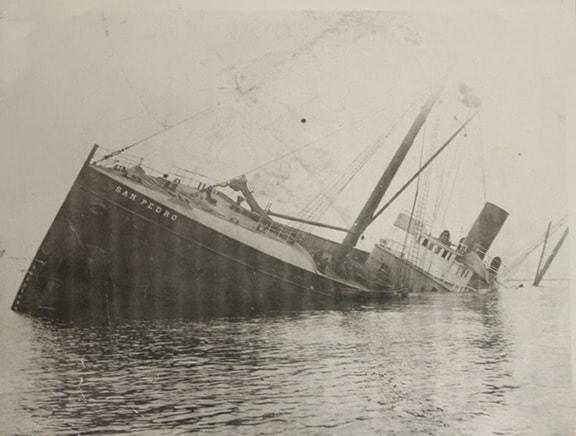How ironic that the fastest collier in the west coast trade which had earned $9 million for her owners in just nine years was uninsured.
You may have noticed by now that I like to tie these historical rambles to current news happenings; when history seems to mimic if not quite repeat itself.
A recent case in point is the grounding and lengthy salvage of a barge loaded with scrap metals which broke loose from a tug’s towline and grounded off Victoria’s Dallas Road waterfront. What looked, to a layman, like a straightforward job of patching any holes then pulling it free took almost three expensive weeks. Marine salvage is never easy — as salvagers found out to their great cost in these very waters, 125 years ago.
That’s when the fine collier San Pedro struck Brotchie Ledge in seas as “smooth as a millpond” while under the guidance of an experienced ship’s pilot. There were no casualties but attempts to back her off failed and she listed to port after coming to rest on her starboard bilge. The Colonist immediately declared “the finest collier on the Pacific Coast” to be a total loss.
Only the collier Wellington (which the San Pedro had helped to rescue but weeks before) and the ship Standard were immediately available to give assistance and they were soon alongside.
By then it was daylight and, as happened last month, hundreds of spectators lined Dallas Road, some even crowding round the half-submerged wreck in small boats, to watch, fascinated, as the crews of all three ships and 20 hastily recruited longshoremen jettisoned the Pedro’s cargo. They were desperate to lighten her before the falling tide could heel her over and flood her engines which were still powering the pumps.
When a rising tide brought no relief and she remained fast on the ledge, navy divers soon found the cause: a 20-foot-long break in her stem, a four-foot-square hole in the bow and a five-inch-wide crack that extended as far aft as the bridge. These injuries, to quote the newspaper, were “enough to show that the ship [is] all but doomed”.
But salvagers continued jettisoning coal from her holds until a sudden lurch caused the Pedro to settle by the stern, forcing those still aboard to jump for their lives. The collier now lay in six fathoms, resting upon her broken bow at a 45-degree angle, and prompting the verdict of most marine experts that she’d “never float again”.
How ironic that the fastest collier in the west coast trade which had earned $9 million for her owners in just nine years, was uninsured. When her owners abandoned her after being apprised that she was in much worse condition than originally reported, a group of Victoria mariners and businessmen decided to make a serious attempt to refloat her before winter storms reduced her to rubble.
After encircling her with log booms to reduce her vulnerability to southeasterly or southwesterly gales, they continued removing her cargo. All the while, looking over their shoulder as it had become known that renowned San Francisco salvager Capt. T.P.H. Whitelaw was showing an interest in the wreck.
This raised the imperialistic ire of the Colonist which raged, “If British ships are not permitted to save vessels in American waters, American ships should not be allowed to do salvage in British waters.”
Nevertheless, it was Whitelaw who carried on removing the coal and, six weeks after the Pedro struck, he had divers seal bulkheads and compartments throughout the ship and erect wooden cribs 12 feet apart to keep her from shifting. Then 18 eight-sided pontoons, built to order and with a lifting capacity of 400 tons, were placed about the wreck. Once in position, they’d be submerged, secured to the hull by heavy chains then pumped dry.
Things were going so well despite windy weather that Whitelaw bragged, “Within 10 days you will see the San Pedro above water again, just as good, barring the damage she sustained in striking, as when she went down. I have not the slightest doubt of the success of my line of action. With me it is like a doctor setting a broken leg, you know. I have had vessels in the same position before, and am quite confident about this job...”
Alas, for all his hopes and an estimated $100,000 ($2 million by today’s measure) Capt. Whitelaw and those who followed him met with defeat. The San Pedro — what’s left of her — is still on Brotchie Ledge.
But she does have a lasting legacy. Although both her master and her pilot lost their licences it was ruled that the real villain was the practice of deepsea ships having to sail close inshore to pick up and drop off their pilots at Victoria. It was recommended that a larger pilot boat meet the ships farther out to sea — as is done today.
www.twpaterson.com
